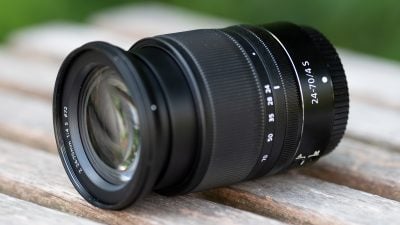Nikon Z 24-70mm f4S review
-
-
Written by Thomas
Quality
Sharpness and contrast
Let’s have a look at the theoretical performance of the new Nikon Z 24-70mm f4S first and compare it to the performance of the Nikon 24-70mm f2.8E VR:
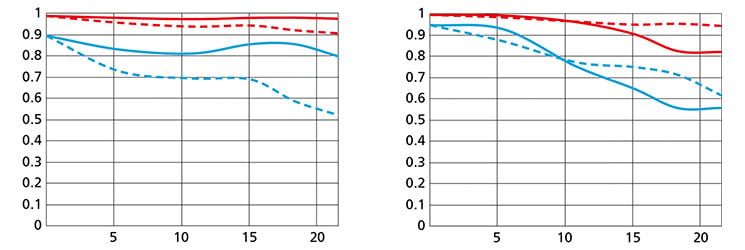
Above: MTF Nikon Z 24-70mm f4S at 24mm, f4.0 (left) and 70mm, f4.0 (right)
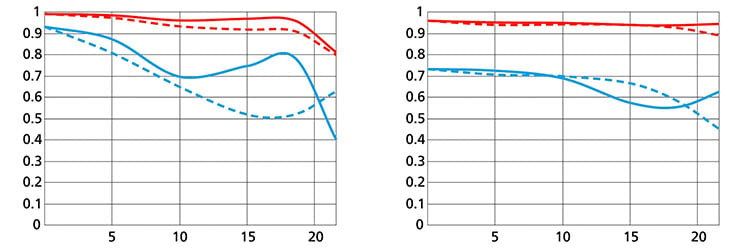
Above: MTF Nikon 24-70mm f2.8E VR at 24mm, f2.8 (left) and 70mm, f2.8 (right)
These MTF charts show the computed lens-performance of lenses wide open without influence of diffraction. Higher values are better (more contrast) and the closer the line-pairs are together the less astigmatism (= resolution depends on the orientation of the test-pattern) the lens has. The x-axis displays the distance from the optical axis (=center of the sensor) in mm. I’ll show you the real-life performance at 4 mm (center), 13 mm (APS-C/DX-corner), and 20 mm (FF/FX-corner) on a 46MP Nikon Z7 body.
From the charts the new Nikon Z 24-70mm f4S should have an advantage over the Nikon 24-70mm f2.8E VR at the short end. Not so much in overall contrast (red lines) but in the fine detail where the older Nikon has a distinct drop at 10mm image height and then again towards the extreme corner of a full-frame sensor. Keep in mind though that the 24-70mm f2.8E VR is shown here wide open at f2.8 while the new Z 24-70mm f4S is measured at f4.0. At the long end the new lens shows very high resolution up to 7mm image height at f4.0 but drops below the 24-70mm f2.8E VR (again: at f2.8) from 10mm onwards with a gradual decline towards the full-frame corner. The 24-70mm f2.8E VR shows its hallmark performance at 70mm where overall contrast and the reproduction of fine details stays almost the same across the full-fame sensor: not bitingly sharp in the center but one of the best performances of a standard zoom towards the corners.
Let’s see how this theoretical performance translates into real life results in the sharpness test based on Siemens-stars. Processing was done in Lightroom 8/CRAW 11 from RAW to Adobe Color profile with the built-in lens profile applied. Noise-reduction is set to 0, sharpening to 50/0.5/36/10, with no extra tone, color, or saturation adjustment. White-balance was adjusted to a neutral white and I did some exposure compensation to make the brightness of all crops match. So you will not see light fall-off in the corners. Removal of lateral color aberrations is ON, longitudinal CA are not corrected.
The following are all 100% crops!
First up is an overview of the wide-open performance at different focal lengths. You can jump to the detailed results at different apertures and comparisons with the competition by clicking on the crops of the respective focal length.
Nikon Z 24-70mm f4S; 100% crop from center, APS-C/DX-corner, FF/FX-corner

Above: 24mm, f4.0

Above: 28mm, f4.0

Above: 35mm, f4.0

Above: 49mm, f4.0

Above: 70mm, f4.0
Nikon’s new lens is very sharp in the APS-C/DX image circle throughout the zoom-range. Only the FF/FX-corner shows varying sharpness at different focal lengths: It’s weakest at 24mm with a high degree of astigmatism but sharpens up quickly at 28mm already. Further towards the long end there is some variation but all-in-all the corner resolution stays at a good level. The lens also exhibits only very little field curvature over its complete zoom range. Bravo!
If you want to see all the details and comparisons with the reference zoom in its class, the Nikon 24-70mm f2.8E VR, read on. Or you can fast-forward to the performance at long distances.
The following 100% crops for each focal length show the new Nikon Z 24-70mm f4S from f4.0 down to f11 compared to the Nikon 24-70mm f2.8E VR (shot on a D850 without application of a lens profile) at f4.0.
Performance at 24mm:
Nikon Z 24-70mm f4S at 24mm; 100% crop from center, APS-C/DX-corner, FF/FX-corner

Above: Nikon Z 24-70mm f4S at 24mm, f4.0

Above: Nikon 24-70mm f2.8E VR on a D850 at 24mm, f4.0

Above: Nikon Z 24-70mm f4S at 24mm, f5.6

Above: Nikon Z 24-70mm f4S at 24mm, f8.0

Above: Nikon Z 24-70mm f4S at 24mm, f11
Compared to the new Z 24-70mm f4S at f4.0 the Nikon 24-70mm f2.8E VR is slightly sharper in the center albeit at the cost of showing some longitudinal CAs (hence the reddish cast) while the DX-corner is a tad softer and the FX-corner clearly sharper but showing strong astigmatism. The weakness in the FX-corner of the new Z 24-70mm f4S only gradually becomes better when stopping down before diffraction sets in at f11.
Performance at 28mm:
Nikon Z 24-70mm f4S at 28mm; 100% crop from center, APS-C/DX-corner, FF/FX-corner

Above: Nikon Z 24-70mm f4S at 28mm, f4.0

Above: Nikon 24-70mm f2.8E VR on a D850 at 28mm, f4.0

Above: Nikon Z 24-70mm f4S at 28mm, f5.6

Above: Nikon Z 24-70mm f4S at 28mm, f8.0

Above: Nikon Z 24-70mm f4S at 28mm, f11
At 28mm focal length the FX-corner of Nikon’s new Z 24-70mm f4S improves markedly and now surpasses the 24-70mm f2.8E VR which has stronger astigmatism.
Performance at 35mm:
Nikon Z 24-70mm f4S at 35mm; 100% crop from center, APS-C/DX-corner, FF/FX-corner

Above: Nikon Z 24-70mm f4S at 35mm, f4.0

Above: Nikon 24-70mm f2.8E VR on a D850 at 35mm, f4.0

Above: Nikon Z 24-70mm f4S at 35mm, f5.6

Above: Nikon Z 24-70mm f4S at 35mm, f8.0

Above: Nikon Z 24-70mm f4S at 35mm, f11
At 35mm both lenses look pretty similar with the 24-70mm f2.8E VR still slightly ahead in the center at the cost of some loCA.
Performance at 49mm:
Nikon Z 24-70mm f4S at 49mm; 100% crop from center, APS-C/DX-corner, FF/FX-corner

Above: Nikon Z 24-70mm f4S at 49mm, f4.0

Above: Nikon 24-70mm f2.8E VR on a D850 at 50mm, f4.0

Above: Nikon Z 24-70mm f4S at 49mm, f5.6

Above: Nikon Z 24-70mm f4S at 49mm, f8.0

Above: Nikon Z 24-70mm f4S at 49mm, f11
50mm focal length seems to be the weak spot of the 24-70mm f2.8E VR where it becomes soft already in the DX-corner. The new Z 24-70mm f4S takes the lead within the DX image circle.
Performance at 70mm:
Nikon Z 24-70mm f4S at 35mm; 100% crop from center, APS-C/DX-corner, FF/FX-corner

Above: Nikon Z 24-70mm f4S at 70mm, f4.0

Above: Nikon 24-70mm f2.8E VR on a D850 at 70mm, f4.0

Above: Nikon Z 24-70mm f4S at 70mm, f5.6

Above: Nikon Z 24-70mm f4S at 70mm, f8.0

Above: Nikon Z 24-70mm f4S at 70mm, f11
Similar picture at 70mm: the new Nikon Z 24-70mm f4S takes the lead over the 24-70mm f2.8E VR right across the full-frame sensor.
Overall Nikon’s new Z 24-70mm f4S standard zoom proves its merit against my reference zoom in this class, the Nikon 24-70mm f2.8E VR. Except for the weakness in the FX-corner at 24mm (which goes away at 28mm) it holds up to or even surpasses the reference lens in resolution and absence of longitudinal CAs.
Performance at long distances
The Siemens-star test-targets are shot at a distance of 45x focal length (i.e. at around 3m for 70mm focal length). But performance of lenses also depends on the shooting distance. Therefore I present another series of test-shots of a city around 1 km away. Processing was done in Lightroom 8/CRAW 11 from RAW to Adobe Color profile with the lens-profile for distortion and vignetting automatically applied. Noise-reduction is set to 0, sharpening to 50/0.5/36/10, with no extra tone, color, or saturation adjustment. I used autofocus at the largest aperture and did not change focus for other apertures. All shots were made at ISO 64 and VR switched off.
First up is an overview of the wide-open performance at different focal lengths. You can jump to the detailed results at different apertures and comparisons with the Nikon 24-70mm f2.8E VR by clicking on the crops of the respective focal length. As usual I have selected the diagonal that provided the better corner results as almost any lens is a bit decentered.
Nikon Z 24-70mm f4S; 100% crop from center, APS-C/DX-corner, FF/FX-corner

Above: 24mm, f4.0

Above: 28mm, f4.0

Above: 35mm, f4.0

Above: 50mm, f4.0

Above: 70mm, f4.0
In this long-distance test the new Nikon Z 24-70mm f4S shows (again) very good performance. But some additional observations are worth mentioning: The weakness in the FX-corner at 24mm does not seem too obvious at longer distances but the DX-corner becomes less well defines from 50mm onwards.
If you want to see all the details and comparisons with the Nikon 24-70mm f2.8E VR, read on. Or fast-forward to the next chapter on vignetting.
The main image shows the complete scene wide open to give you an impression of the angle of view and to judge vignetting. You can access the respective shots up to f11 via the links beneath the main image. Following the main image are 100% crops for each focal length from the new Nikon Z 24-70mm f4S down to f11 compared to the Nikon 24-70mm f2.8E VR (shot on a D850 without application of a lens profile) at f4.0. Both lenses were shot on the same day except for the Nikon 24-70mm f2.8E VR at 50mm which was shot the next day with slightly higher air humidity.
You can click on each image to access the large original. Please respect our copyright and only use those images for personal use.
Results at 24mm:
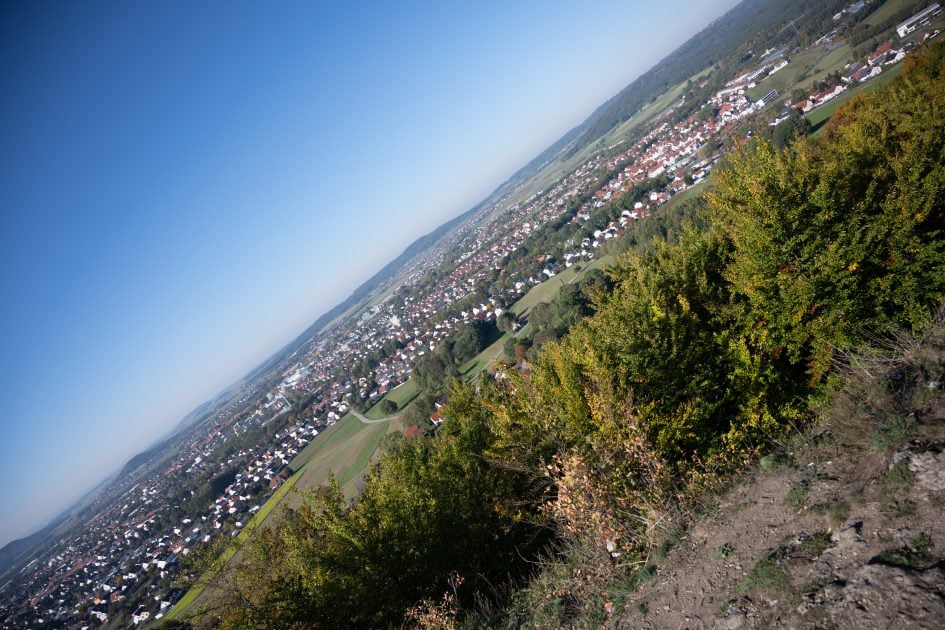
Above: Nikon Z 24-70mm f4S at 24mm, f4.0; click image to access original at Flickr; also available at f5.6, f8.0, f11

Above: Nikon Z 24-70mm f4S at 24mm, f4.0; 100% crop from center, APS-C/DX-corner, FF/FX-corner

Above: Nikon 24-70mm f2.8E VR on a D850 at 24mm, f4.0; 100% crop from center, APS-C/DX-corner, FF/FX-corner; also available at f2.8, f5.6, f8.0, f11

Above: Nikon Z 24-70mm f4S at 24mm, f5.6; 100% crop from center, APS-C/DX-corner, FF/FX-corner

Above: Nikon Z 24-70mm f4S at 24mm, f8.0; 100% crop from center, APS-C/DX-corner, FF/FX-corner

Above: Nikon Z 24-70mm f4S at 24mm, f11; 100% crop from center, APS-C/DX-corner, FF/FX-corner
The new lens looks clearly sharper than its bigger brother at the DX-corner.
Results at 28mm:
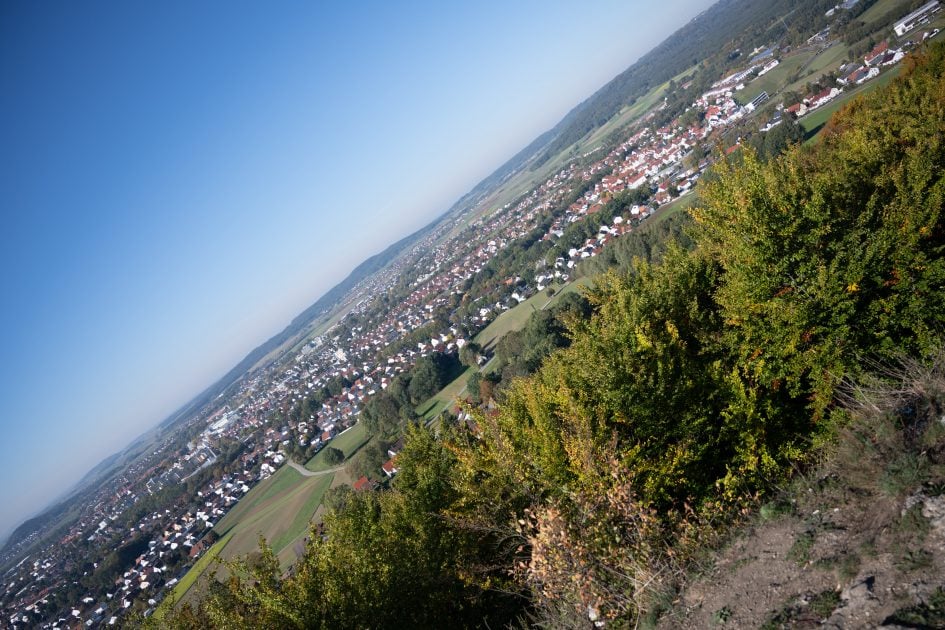
Above: Nikon Z 24-70mm f4S at 28mm, f4.0; click image to access original at Flickr; also available at f5.6, f8.0, f11

Above: Nikon Z 24-70mm f4S at 28mm, f4.0; 100% crop from center, APS-C/DX-corner, FF/FX-corner

Above: Nikon 24-70mm f2.8E VR on a D850 at 28mm, f4.0; 100% crop from center, APS-C/DX-corner, FF/FX-corner; also available at f2.8, f5.6, f8.0, f11

Above: Nikon Z 24-70mm f4S at 28mm, f5.6; 100% crop from center, APS-C/DX-corner, FX-corner

Above: Nikon Z 24-70mm f4S at 28mm, f8.0; 100% crop from center, APS-C/DX-corner, FX-corner

Above: Nikon Z 24-70mm f4S at 28mm, f11; 100% crop from center, APS-C/DX-corner, FF/FX-corner
Again the DX-corner goes to the new Z 24-70mm f4S with the rest looking pretty similar.
Results at 35mm:
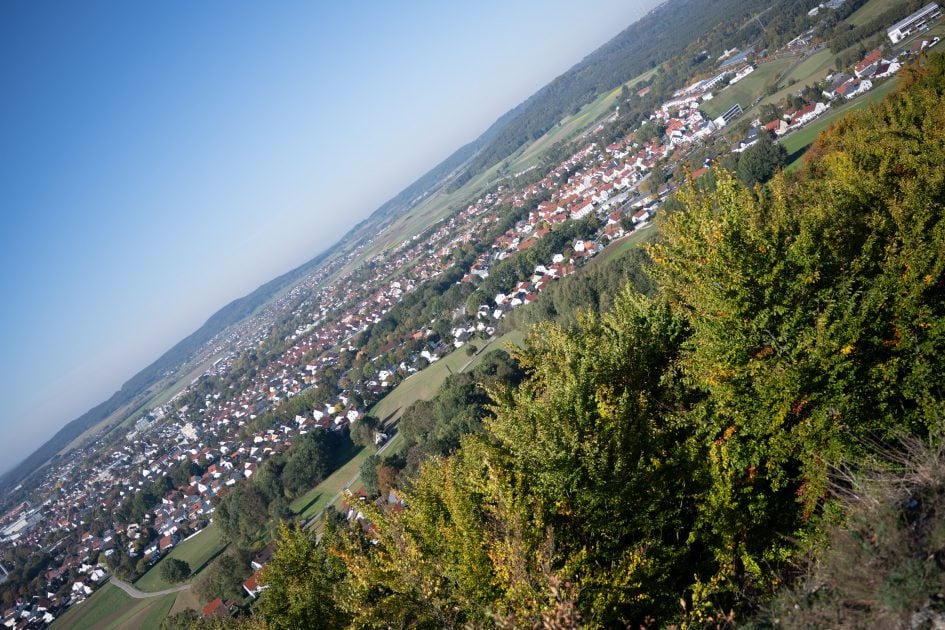
Above: Nikon Z 24-70mm f4S at 35mm, f4.0; click image to access original at Flickr; also available at f5.6, f8.0, f11

Above: Nikon Z 24-70mm f4S at 35mm, f4.0; 100% crop from center, APS-C/DX-corner, FF/FX-corner

Above: Nikon 24-70mm f2.8E VR on a D850 at 35mm, f4.0; 100% crop from center, APS-C/DX-corner, FF/FX-corner; also available at f2.8, f5.6, f8.0, f11

Above: Nikon Z 24-70mm f4S at 35mm, f5.6; 100% crop from center, APS-C/DX-corner, FX-corner

Above: Nikon Z 24-70mm f4S at 35mm, f8.0; 100% crop from center, APS-C/DX-corner, FF/FX-corner

Above: Nikon Z 24-70mm f4S at 35mm, f11; 100% crop from center, APS-C/DX-corner, FF/FX-corner
Both lenses look very similar again with the new Z-lens showing a sharper FX-corner.
Results at 50mm:
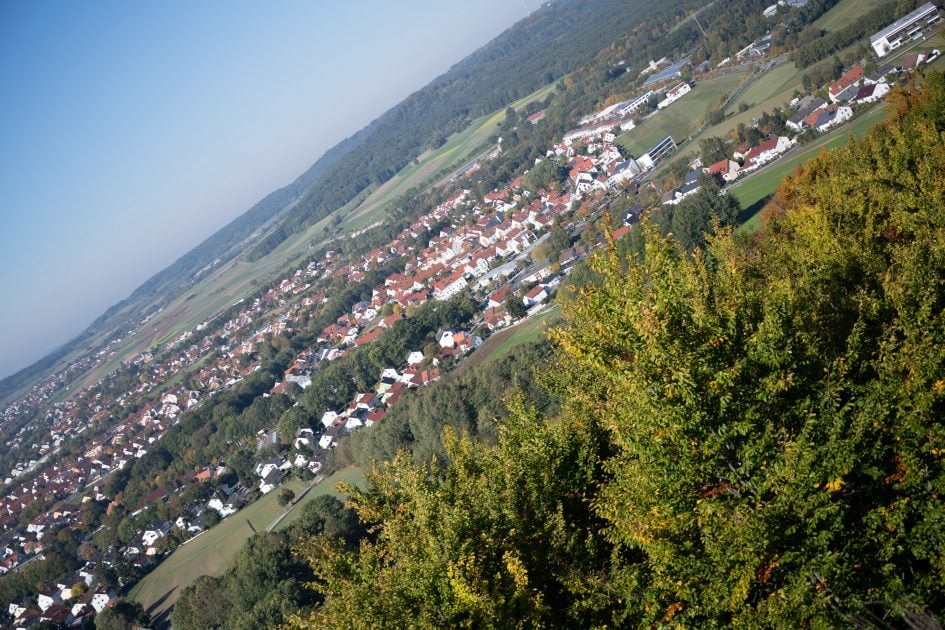
Above: Nikon Z 24-70mm f4S at 50mm, f4.0; click image to access original at Flickr; also available at f5.6, f8.0, f11

Above: Nikon Z 24-70mm f4S at 50mm, f4.0; 100% crop from center, APS-C/DX-corner, FF/FX-corner

Above: Nikon 24-70mm f2.8E VR on a D850 at 50mm, f4.0; 100% crop from center, APS-C/DX-corner, FF/FX-corner; also available at f2.8, f5.6, f8.0, f11

Above: Nikon Z 24-70mm f4S at 50mm, f5.6; 100% crop from center, APS-C/DX-corner, FX-corner

Above: Nikon Z 24-70mm f4S at 50mm, f8.0; 100% crop from center, APS-C/DX-corner, FF/FX-corner

Above: Nikon Z 24-70mm f4S at 50mm, f11; 100% crop from center, APS-C/DX-corner, FF/FX-corner
At 50mm the FX-corner goes to the 24-70mm f2.8E VR, all else looking pretty similar.
Results at 70mm:
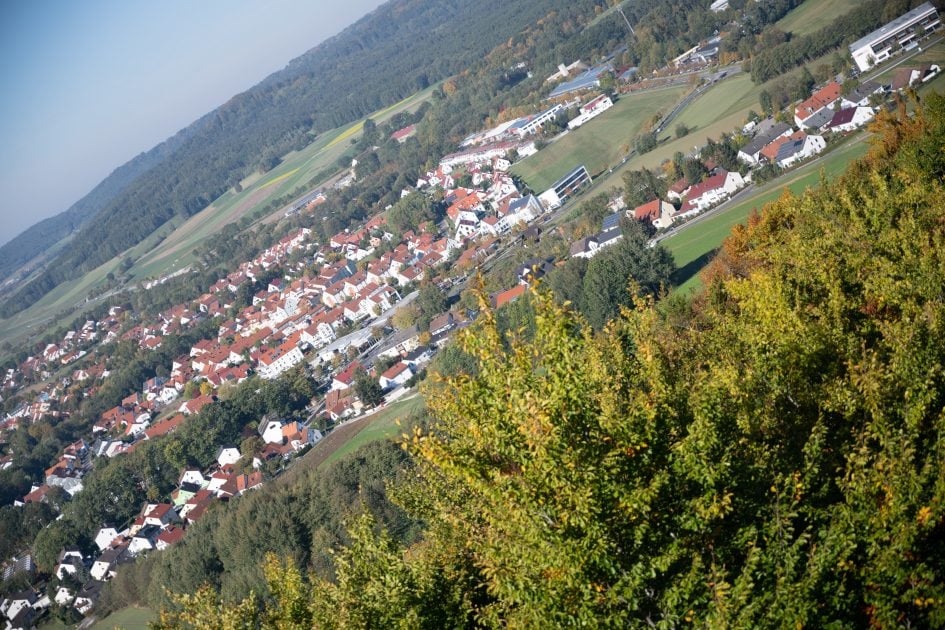
Above: Nikon Z 24-70mm f4S at 70mm, f4.0; click image to access original at Flickr; also available at f5.6, f8.0, f11

Above: Nikon Z 24-70mm f4S at 70mm, f4.0; 100% crop from center, APS-C/DX-corner, FF/FX-corner

Above: Nikon 24-70mm f2.8E VR on a D850 at 70mm, f4.0; 100% crop from center, APS-C/DX-corner, FF/FX-corner; also available at f2.8, f5.6, f8.0, f11

Above: Nikon Z 24-70mm f4S at 70mm, f5.6; 100% crop from center, APS-C/DX-corner, FX-corner

Above: Nikon Z 24-70mm f4S at 70mm, f8.0; 100% crop from center, APS-C/DX-corner, FF/FX-corner

Above: Nikon Z 24-70mm f4S at 70mm, f11; 100% crop from center, APS-C/DX-corner, FF/FX-corner
The new Z 24-70mm f4S has the lead in the center but is softer at the DX- and FX-corner.
The new Nikon Z 24-70mm f4S vies for first place with the reference zoom in this long-distance test. Its weakest area seems to be the long end where it becomes a bit soft at the border of the DX image-circle. But in other instances the new Z-lens takes the lead over the Nikon 24-70mm f2.8E VR.
Vignetting and distortions
Vignetting and distortions are lens aberrations that can be easily corrected by software. Lightroom and Photoshop have offered lens profiles for some time which could be applied as an option. But with the Z series, like most mirrorless systems, Adobe applies lens profiles automatically whether you want them or not. So there is no way to opt out of the application of Nikon’s Z lens profiles when processing them in Adobe’s software – unless you develop your RAWs with another software like RAWTherapee or PhotoNinja.
Some photographers frown upon being denied the choice to develop their RAW files either with or without lens profiles. Below is a RAW from the new lens developed with Lightroom 8/CRAW 10 (with Nikon’s lens profile applied) compared to the same RAW developed in RAWTherapee (no lens profile applied):

Above: Nikon Z 24-70mm f4S at 24mm, f6.3, developed from RAW in Lightroom (left) and RAWTherapee (right)
As you can see the application of the lens profile produces an image that has much less distortion and vignetting. So this should be a good thing? Well, not completely. For one, the angle of view is a bit narrower cutting off the last millimeter or so of the image in the full-frame corners (this happens only with barrel distortions not with pin-cushion distortions). But the Z7 applies the lens profile of the Z 24-70mm f4S also in Live View when composing the shot. So what you get (in your final image) is what you see (through the viewfinder). But if you use e.g. the Nikon 24-70mm f2.8E VR via FTZ adapter on the Z7 that lens profile is not applied to the viewfinder/Live View or when shooting a video although it is in the photography RAW files.
Then there is the aspect of a very slight loss of resolution as pixels in the processed file have been wrangled to some degree and no longer exactly match the pixels on the sensor. And lastly lifting exposure compensation in the corners to fight vignette leads to a reduced dynamic range and potentially increased noise – fortunately only in the corners. Note: the above example is not conducive in showing these effects.
All in all I believe the benefits of using a lens profile to reduce distortions and vignetting far outweigh the above mentioned side-effects. Plus, today lenses are developed together their lens profiles for optimal results. Thus it makes sense to use manufacturer-supplied lens profiles on all images from modern mirrorless cameras. This also conforms with the wide majority of use cases in the field – although traditional Nikon (and Canon) DSLR users may have to get accustomed to it.
Now, to make it easier to see light fall-off in the corners of a full-frame sensor I’ve arranged a series of three shots each with the new Nikon at different apertures. All images were developed to the same brightness in the center and the lens profile applied, vignette control in camera was set to normal (the default). The first line shows vignetting at 24mm focal length, the second at 70mm:
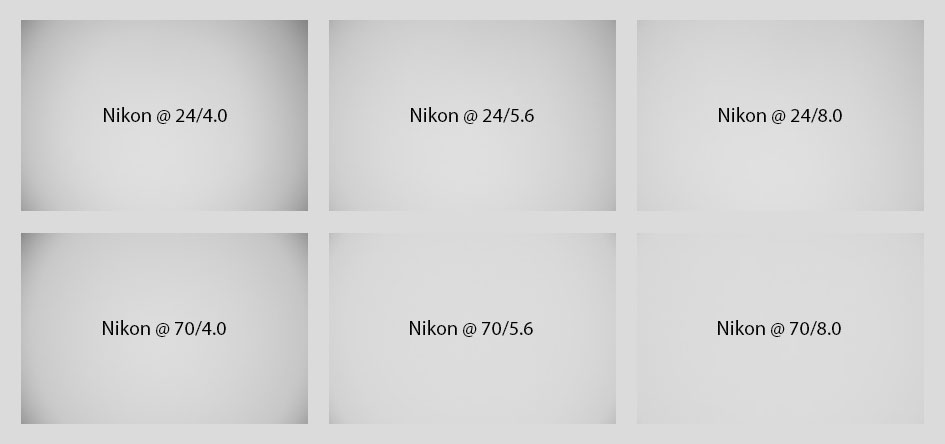
Above: Nikon Z 24-70mm f4S at 24mm and 70mm focal length
The sample images above show that even with the lens profile applied vignetting is not completely eliminated. Technically it would have been easy to do so but that would give the rendering of any lens a flat/artificial feeling. So Nikon probably opted to leave this small amount of light falloff with the profile. You can easily eliminate it completely in post processing.
Distortions are very well corrected through the lens profile as you can see in the examples at the end of the samples page.
Rendering of point-light sources at night-shots
Night-shots pose a different challenge for lenses as the contrast is even higher than under bright sun and point-light sources can reveal some weaknesses such as coma, haloing and colour-aberrations that do not show up as prominently in other test-shots. The 100% crops below the main image show the effect of coma in the FF/FX-corner of the new Nikon and the Nikon 24-70mm f2.8E VR at various apertures:
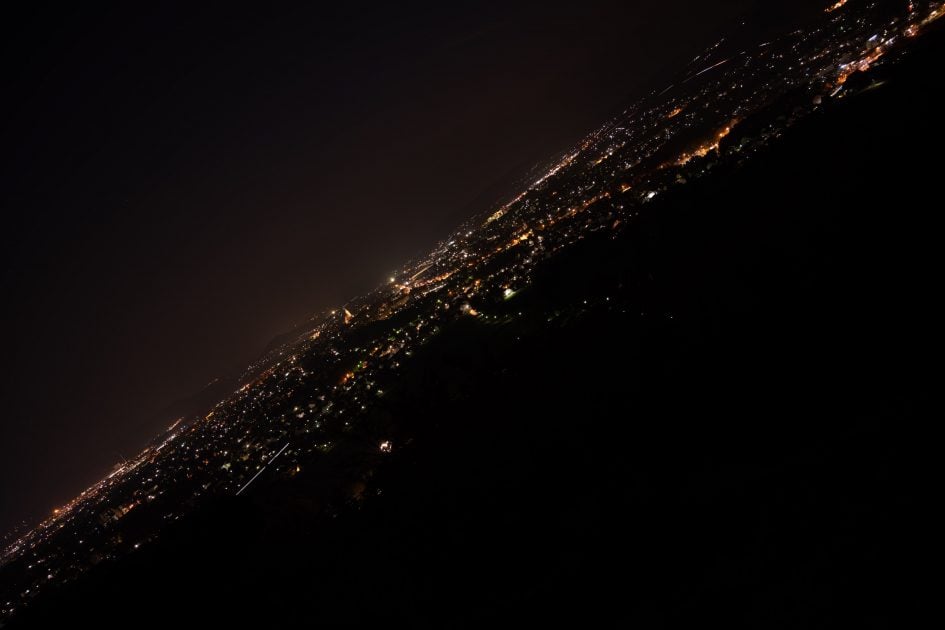
Above: Nikon Z 24-70mm f4S at 24mm, f4.0; also available at f5.6, f8.0

Above: Nikon Z 24-70mm f4S at 24mm; 100% crops from the FF/FX-corner at f4.0 (left), f5.6 (middle), f8.0 (right)

Above: Nikon 24-70mm f2.8E VR at 24mm; 100% crops from the FF/FX-corner at f2.8 (left), f4.0 (middle), f5.6 (right)
On the short end the new Nikon Z 24-70mm f4S has a little less coma than the already pretty good Nikon 24-70mm f2.8E VR.
Coma at 70mm:
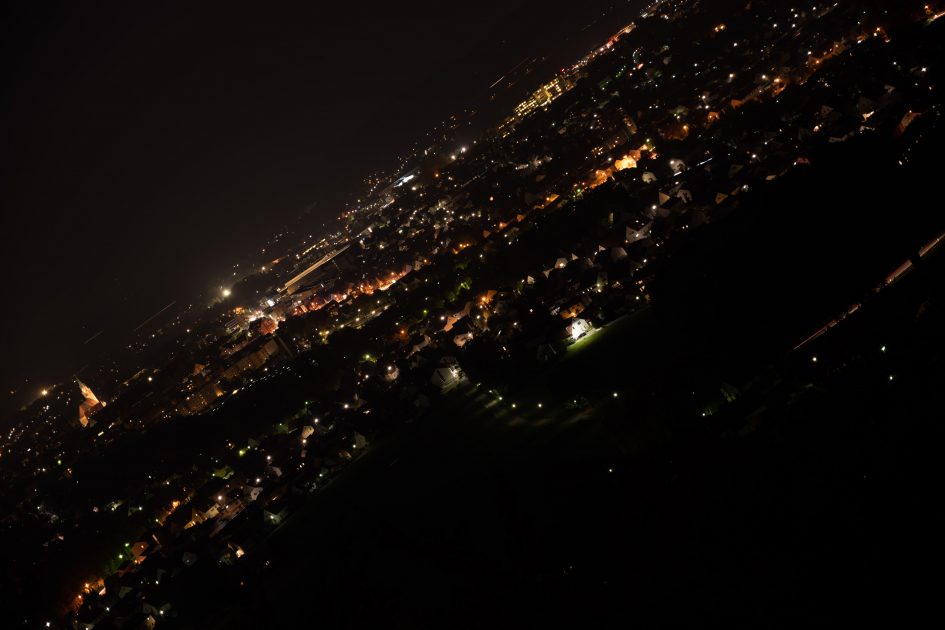
Above: Nikon Z 24-70mm f4S at 70mm, f4.0; also available at f5.6, f8.0

Above: Nikon Z 24-70mm f4S at 70mm; 100% crops from the FF/FX-corner at f4.0 (left), f5.6 (middle), f8.0 (right)

Above: Nikon 24-70mm f2.8E VR at 70mm; 100% crops from the FF/FX-corner at f2.8 (left), f4.0 (middle), f5.6 (right)
On the long end the new Nikon Z 24-70mm f4S shows more coma at f4.0 than the 24-70mm f2.8E VR at f2.8.
Rendering of out-of-focus point-light sources
This test is for the rendering of point-light sources in an out-of-focus background. The circle of confusion that is produced by this test is pretty indicative of Bokeh performance (in the background) and light fall-off. Ideally the out-of-focus image of the point-light is evenly lit and perfectly circular, with no “onion-rings”, and without coloration. Large aperture lenses normally produce an effect known as “cat’s eye” the further away from the optical axis the point-light is projected. This is due to optical vignetting in the lens barrel when light enters the lens from an angle.
All images were shot at the longest focal length and largest aperture. The new Nikon is first followed by the Nikon 24-70mm f2.8E VR.
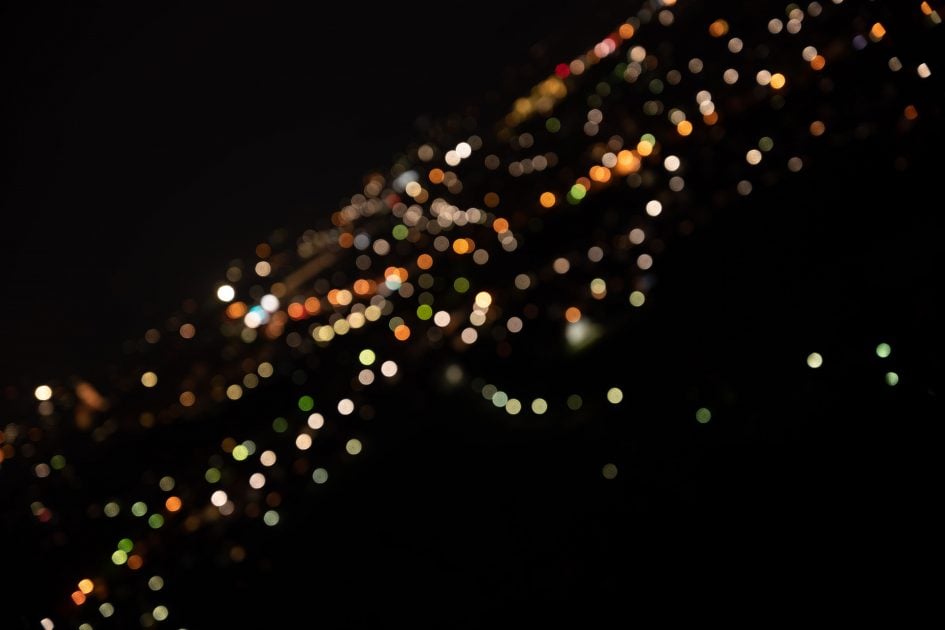
Above: Nikon Z 24-70mm f4S at 70mm, f4.0; also available at f5.6, f8.0

Above: Nikon Z 24-70mm f4S at 70mm, f4.0; 44% crops from center, DX-corner, FX-corner

Above: Nikon 24-70mm f2.8E VR at 70mm, f4.0; 44% crops from center, DX-corner, FX-corner; also available at f2.8, f5.6, f8.0
When shot at the same f4.0 aperture both lenses look very similar in the center: the new Z 24-70mm f4S showing a slightly brighter outline while the Nikon 24-70mm f2.8E VR has a green outline due to loCA. Texture within the circle is roughly comparable with no strong onion rings. Looking towards the corners reveals some differences though: The new lens shows no compression of the Bokeh balls up 17mm image height (well outside the DX image-circle) while deformation of the circular shape starts already at 11mm image height with the the 24-70mm f2.8E VR which is very visible in the DX-corner. Naturally the Nikon 24-70mm f2.8E VR can produce bigger Bokeh balls when shot at f2.8.
Now let’s see how this analysis of out-of-focus point-light sources translates into Bokeh-performance shooting a book-shelf.
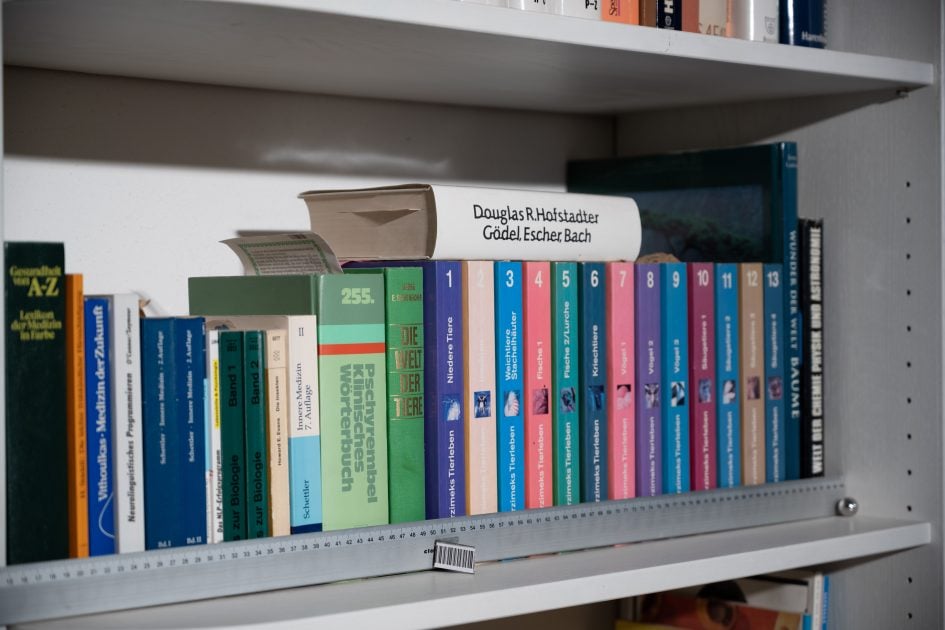
Above: Nikon Z 24-70mm f4S at 70mm, f4.0; also available at f5.6, f8.0

Above: Nikon Z 24-70mm f4S at 70mm, f4.0; 44% crops from foreground, middle-ground, background

Above: Nikon 24-70mm f2.8E VR at 70mm, f2.8; 44% crops from foreground, middle-ground, background; also available at f4.0, f5.6, f8.0
Comparing the lenses at their longest focal length and largest aperture these test shots show the advantage of the Nikon 24-70mm f2.8E VR when shot at f2.8. Foreground, background, and the transition zone (middle-ground) are much softer than from the new Z 24-70mm f4S at f4.0. The only advantage of the new Z-lens is the freedom from loCA which prevents the transition zone to show a greenish coloration.
Close-up performance
As the new Z Nikkor goes down to 1:3.1 magnification (just like its bigger brother) it is interesting to see how the lens performs in close-up shooting. The following images were shot at 1:4 magnification where the area if sharp focus is just 96 x 144mm. The crops shown below are from 2mm, 8mm, and 17mm off the center of the sensor respectively:

Above: Nikon Z 24-70mm f4S at 70mm, f5.6; 100% crops

Above: Nikon 24-70mm f2.8E VR at 70mm, f5.6; 100% crops
The new Z Nikkor produces very usable results while the Nikon 24-70mm f2.8E VR clearly falls back in this comparison. The older lens also fights with some focus-shift in close-up situations which makes it hard to nail focus with phase-detect AF. The example above was focused in live-view at f5.6 to avoid any problems while the Z 24-70mm f4S was simply focused at f4.0 and then stopped down.
Flare, ghosting, and sun-stars
Catching a strong light-source shining directly into the lens is always a risky business: it could produce strange colourful ghost-images or reduce contrast considerably through flare and glare. The appearance of flare and ghosting depends on factors like the aperture and the angle of the light hitting the lens. So to judge the proclivity of the new Nikon Z 24-70mm f4S for these artefacts I went through a series of well calculated shots against a strong light source to provoke glare and ghosting.
The new Nikon Z 24-70mm f4S is amazingly clear of flare and glare artefacts at the short end and at the long end it’s also very clean. And outside these artefacts the new lens renders a deep black, so there’s little veiling glare. This is a much better performance than from the Nikon 24-70mm f2.8E VR. See a comparison of both lenses at 70mm f11 where the effects are most obvious:
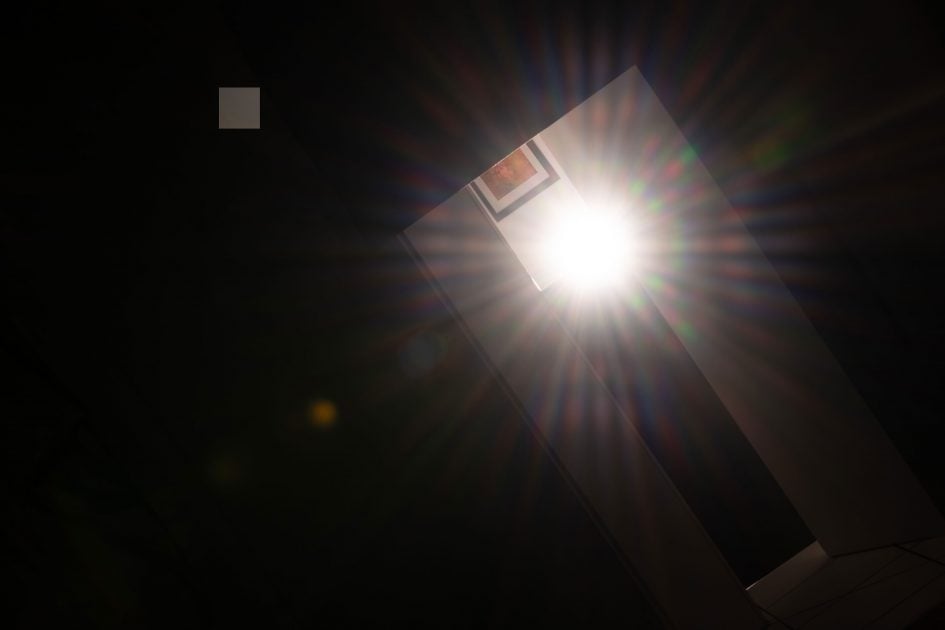
Above: Flare and ghosting. Strong light hitting the Nikon Z 24-70mm f4S at 70mm, f11
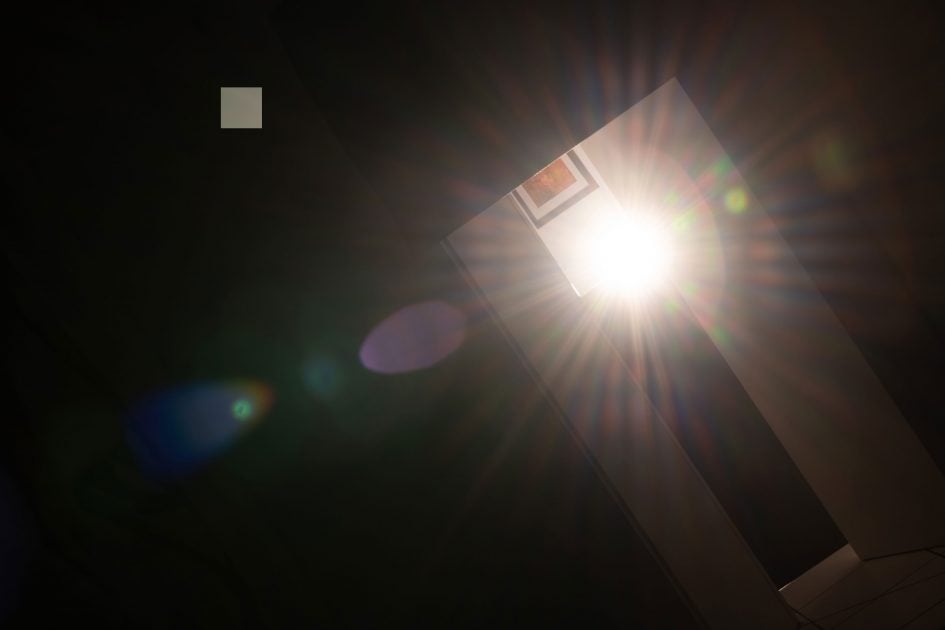
Above: Flare and ghosting. Strong light hitting the Nikon 24-70mm f2.8E VR at 70mm, f11
The little bright square inset in the upper left of both images shows the respective area with an exposure compensation of +3 EV to make it easier to see which levels of black the lens renders at that point. It clearly shows that the Nikon 24-70mm f2.8E VR produces more veiling glare than the new Z Nikkor.
The new Nikon Z 24-70mm f4S produces sunstars at 24mm focal length even wide open at f4.0. This is a consequence of the lens closing its physical aperture when zooming out towards the short end. At 70mm focal length the lens does not show any sunstars at f4.0 due to the perfectly round aperture and even at f11 sunstars are pretty weak as you can see in the image above.
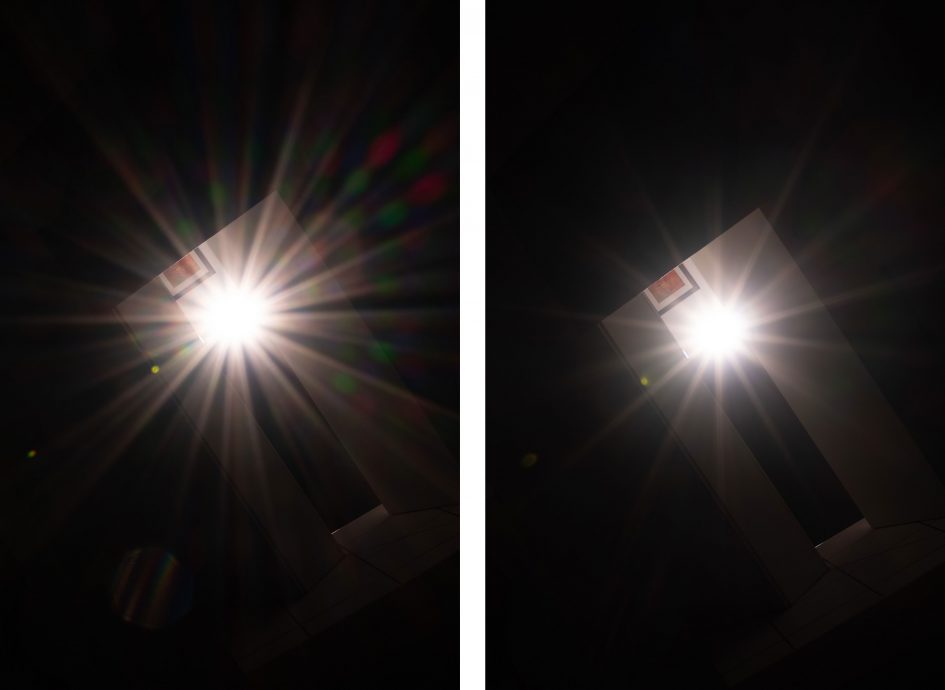
Above: Nikon Z 24-70mm f4S at 24mm, f11 (left) and f4 (right), cropped
Next check out my sample images!
Check prices on the Nikon Z 24-70mm f4S at Amazon, B&H, Adorama, or Wex. Alternatively get yourself a copy of my In Camera book or treat me to a coffee! Thanks!



